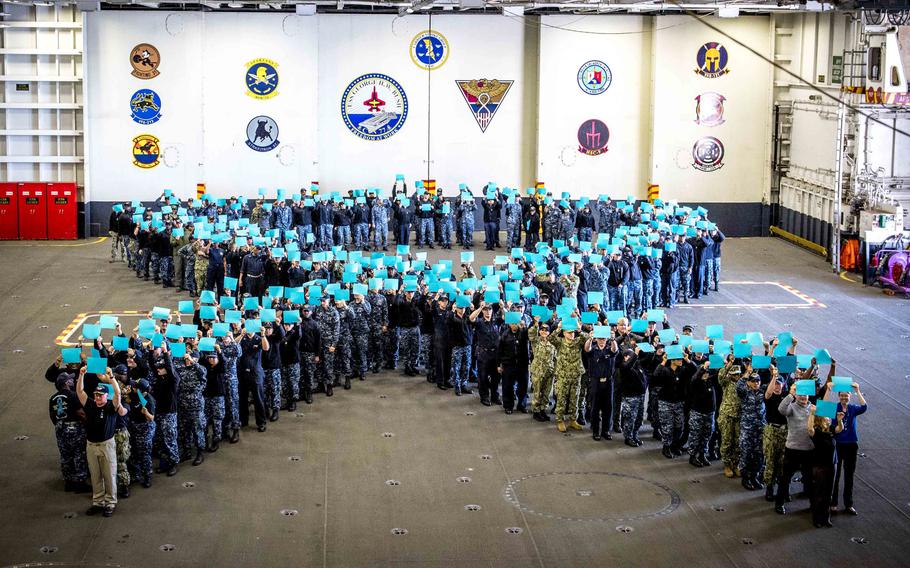
Sailors aboard the aircraft carrier USS George H.W. Bush (CVN 77) stand in the shape of a ribbon holding teal paper to recognize Sexual Assault Awareness and Prevention Month. (Hank Gettys/U.S. Navy )
The United States Navy prides itself on its core values of honor, courage and commitment. But when it comes to addressing two of the most pressing issues facing our force — sexual harassment and suicide — it has chosen a path that, while well-intentioned, misses the mark. Instead of teaching its leaders to own these issues as part of their foundational responsibilities, the Navy a created separate workforces dedicated to preventing sexual harassment and suicide. This approach undermines the very essence of leadership and accountability.
To be clear, sexual harassment and suicide in the ranks are not administrative issues. They are leadership failures. Yet, by assigning responsibility to separate offices or specialists, the Navy unintentionally signals that these are peripheral concerns — out of scope for commanding officers, chiefs and division leaders. It suggests that if something goes wrong, someone else will deal with it. That’s not leadership. That’s delegation without ownership and accountability.
Leadership in the Navy means being responsible for the total well-being and performance of your sailors. This includes not only their physical readiness and mission execution but their mental health and professional standards. You can’t separate climate from command. And yet, that’s exactly what happens when prevention efforts are siloed into programs managed by specialists rather than ingrained in leadership development and evaluation. I like to call them stovepipes of excellence.
Instead of building standalone workforces for suicide and sexual harassment prevention, the Navy should embed these subjects deeply into its leadership continuum. From the earliest stages of officer and enlisted training through to senior-level courses like the Command Leadership School, these topics should not be treated as annual general military training.
Leadership development in the Navy is structured around continuous growth: petty officer indoctrination, Chief Petty Officer Initiation, Senior Enlisted Academy, Officer Candidate School, Command Leadership School, and others. Leadership programs should not just teach operational doctrine or personnel management. They should focus on how to foster a healthy command climate, how to identify and intervene when a sailor is struggling, and how to set a tone of zero tolerance for harassment and abuse. And it must go beyond PowerPoint briefings and checkbox training. It requires real, scenario-based learning, open dialogue, and hard conversations.
Moreover, accountability must be non-negotiable. A command where harassment is pervasive or mental health issues go unaddressed should reflect a failure in leadership. Leaders must be evaluated and held accountable for the climate they foster. This is already feasible. The Command Climate Assessment tool exists. Mental health trends, incident reports, retention rates and anonymous feedback mechanisms all provide leaders and higher headquarters with visibility into how a command is truly functioning. These tools should be used not just to identify problems but to inform fitness reports, evaluations and promotion decisions.
Accountability does not mean punishing every leader when tragedy strikes. However, it does mean rigorously examining whether leaders took every reasonable step to prevent it, to connect with their sailors, and to foster a culture where asking for help isn’t stigmatized. If they didn’t, that’s not a failure of policy — it’s a failure of leadership.
Some will argue that having a dedicated workforce ensures expertise and consistency. That’s valid — to a point. Subject matter experts still have a role to play: as advisers, trainers and resource coordinators. But they cannot and should not be the ones responsible for the outcomes. Just as a medical officer advises on health but doesn’t control command readiness, prevention officers should support — not supplant — leaders’ responsibilities.
There is also the question of trust. Sailors are more likely to come forward when they believe their chain of command will take them seriously, respond appropriately, and protect them. That trust cannot be outsourced to a separate workforce. It must be earned by the leaders they serve under every day. When a junior sailor sees that their leading petty officer, chief, or division officer is engaged, aware and compassionate, that creates a command climate where people feel seen and valued.
Leaders should memorize Teddy Roosevelt’s quote, “People don’t care how much you know until they know how much you care.”
The Navy doesn’t need more initiatives. It needs stronger leaders. That means holding commanding officers and command master chiefs to the same standard on climate and welfare as they are held on mission readiness. It means recognizing that sailors of any rank are not secondary concerns — they are prerequisites to combat effectiveness.
We ask a great deal of our leaders already and telling them to truly take care of their people is not an added burden. Leadership is a verb and the job.
Incorporating sexual harassment and suicide prevention into the leadership continuum is not just a matter of administrative efficiency — it is a moral imperative. It’s how we restore trust, improve readiness, and most importantly, save lives.
Leadership is the Navy’s most decisive advantage. Let’s use it where it matters most.
Ken Falke, a retired EOD master chief petty officer, is a 21-year U.S. Navy Explosive Ordnance Disposal veteran. He is chairman and founder of Boulder Crest Foundation, an organization focused on the teachings of posttraumatic growth. He is also the author of “Struggle Well: Thriving in the Aftermath of Trauma” and “Lead Well: 10 Steps to Successful and Sustainable Leadership.”